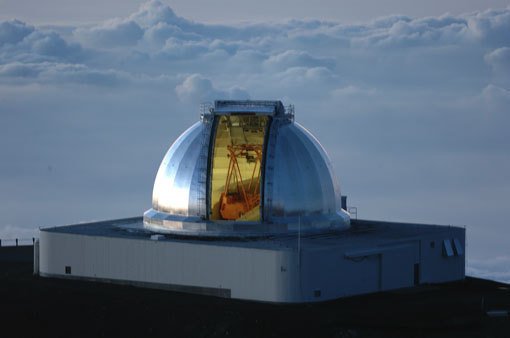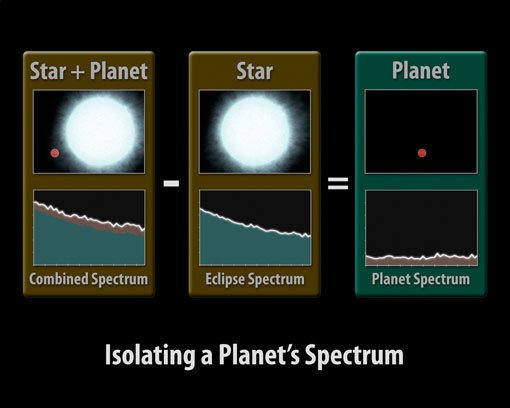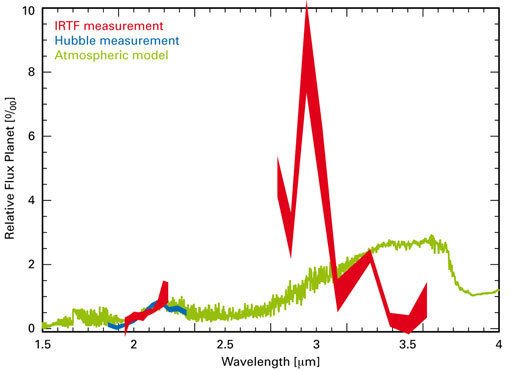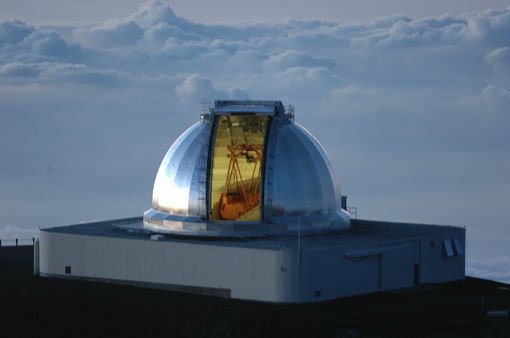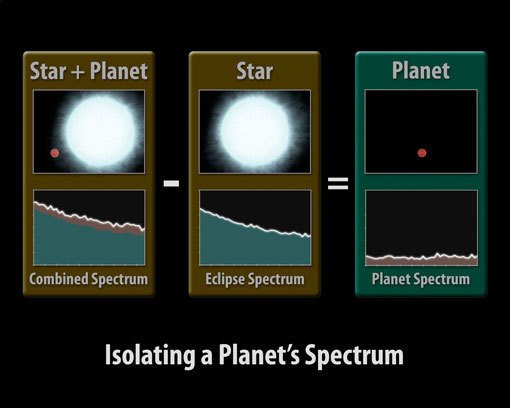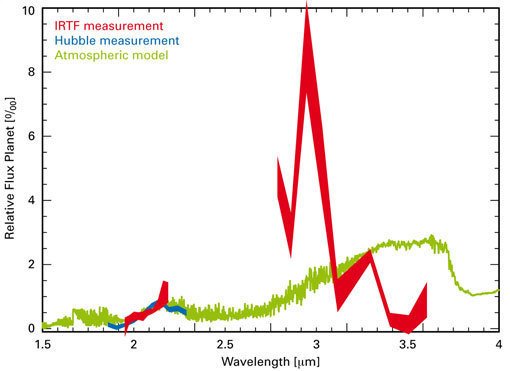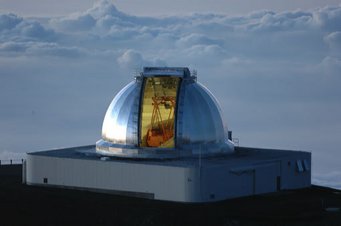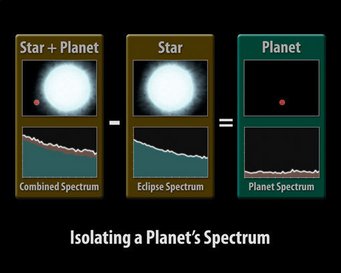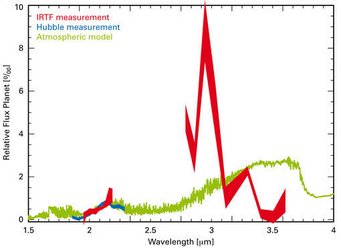Probing exoplanet chemistry without the need for space telescopes
A group of astronomers, which includes researchers from the Max Planck Institute for Astronomy, has successfully tested a new method for probing the chemical composition of the atmospheres of planets that orbit distant stars. The technique can be used by comparatively small telescopes on the ground, making exoplanet chemistry more widely accessible than ever before. First observations have yielded a fundamentally new result about exoplanet atmospheres. The results have been reported in the February 4, 2010 issue of the journal Nature.
| Background information | Questions & Answers | Image download |
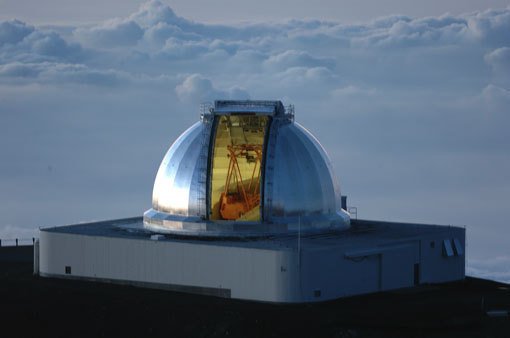
Chemical studies of exoplanets – planets that orbit not the Sun, but distant stars ö rely on spectroscopy, the systematic study of light emitted, reflected or absorbed by those planets at different colors, or wavelengths. Such studies used to be the domain of space observatories and of the world's largest ground-based telescopes (see the MPIA Science Release 2010-01-13). Now, a new data analysis technique successfully pioneered by a group of astronomers from the US, the UK and Germany has brought exoplanet spectroscopy to a much smaller (and more wide-spread) class of ground-based telescopes.
It took the researchers more than two years to develop their method so that it could be applied to spectroscopic observations of the exoplanet HD 189733b made in 2007 with a 3 metre telescope. Using the new method, the identification of specific molecules such as methane and carbon dioxide became possible. The planet, a gas giant similar to Jupiter, orbits the star HD 189733 A in the constellation Vulpecula (or “Fox”), at a distance of 63 light-years from Earth. The spectrum included an interesting wavelength region that is not observable with current space telescopes.
As seen from Earth, the planet HD 189733b periodically moves behind its host star in a planetary eclipse. The planet's spectrum is extracted by comparing the system's light before and after the star hides the planet from sight. Unfortunately, the same atmospheric turbulence which is responsible for the twinkling of stars in the night sky introduces disturbances that are very difficult to account for. Co-author Jeroen Bouwman of the Max Planck Institute for Astronomy explains: “Using newly developed calibration techniques, we can distinguish the variations in time due to the planetary eclipse from those that are due to atmospheric disturbances, or to instrumental artefacts. In this way, we can tell which part of the light is from the exoplanet, and which from the star.” Previously, this kind of measurement had only been possible with space telescopes, where observing time is rationed out very strictly. Now, exoplanet spectroscopy becomes accessible to dozens of ground-based telescopes with mirror sizes down to a few metres, and without the need for specialized spectrographic equipment.
The study's lead author, Mark Swain from NASA's Jet Propulsion Laboratory (a former guest scientists of the Max Planck Institute for Astronomy) explains further: “The fact that we have used a relatively small, ground-based telescope is exciting because it implies that the largest telescopes on the ground, using this technique, may be able to characterize terrestrial exoplanet targets.” The chemical study of terrestrial, or Earth-like, planets, will be a key step in the search for exoplanets with habitable conditions, or even life on other planets – a crucial, if long-term, aim of modern astronomy. Co-author and MPIA director Thomas Henning adds: “This is exciting news for new instruments such as the LUCIFER spectrograph being installed at the Large Binocular Telescope in Arizona.”
The first measurements using the new techniques provide key data to those modelling exoplanet atmospheres. Previous models were simplified in that they admitted only comparatively slow changes in atmospheric conditions. Researchers knew this to be unrealistic, but did not have sufficient data to distinguish between those overly simplified models and more realistic ones. The new spectroscopic data allows for just such differentiation, allowing astronomers to develop new, more realistic models of exoplanet atmospheres.
Background information
The results described here will be published in the February 4, 2010 issue of Nature, as M.R. Swain et al.: “A ground-based near-infrared emission spectrum of the exoplanet HD 189733b”.
The team members are Mark R. Swain, Pieter Deroo, Gautam Vasisht and Pin Chen (Jet Propulsion Laboratory, Pasadena), Caitlin A. Griffith (University of Arizona), Giovanna Tinetti (University College London), Azam Thatte (Georgia Institute of Technology), Jeroen Bouwman, Cristina Afonso and Thomas Henning (Max Planck Institute for Astronomy), Ian Crossfield (UCLA) and Daniel Angerhausen (German SOFIA Institute, Stuttgart).
Questions and Answers
What is a spectrum?
As every rainbow demonstrates, white light can be split up into different colors. Astronomers artificially split up the light they receive from distant objects into its different colors (or “wavelengths”). However, where we distinguish five or six rainbow colors, astronomers map hundreds of finely nuanced colors, producing a spectrum – a record of the different amounts of light the object emits in each narrow color band. Also, where we see only a rainbow's visible light, astronomers probe other region of the electromagnetic spectrum. The spectra used here were obtained in the infrared region. The spectrum's properties – more light emitted at some colors, less light at others – provide tell-tale signs about the chemical composition of the matter producing the light. Infrared spectra are especially useful for identifying the presence of molecules. All in all, this makes spectroscopy, the recording of spectra, a key tool for astronomy: Spectra tell us what distant astronomical objects are made of.
How can an eclipsing planet's spectrum be observed?
From Earth, we can observe how, with each orbit, the planet passes once in front of the star (the “primary eclipse”), and once behind it (the “secondary eclipse”). While it is currently impossible to observe this particular planet and its host star separately – the two are too close, and the star's glare is too bright; in fact, such observations have only been achieved once so far, cf. this MPIA press release – the eclipses offer several opportunities of extracting the planet's spectrum: During the primary eclipse the star's light is dimmed, as part of it is shielded by the planet; this allows for an estimate of the planet's size. Part of the light shines through the thin shell of the planet's atmosphere (“transmission spectroscopy”); by determining the specific colors that are absorbed by the atmosphere (“absorption lines”), the observers can infer the presence of specific molecules in the atmosphere.
Comparing the light received directly before the secondary eclipse, just before the planet has vanished behind the star, and during the eclipse, provides another opportunity to tell which part of the light received from the system is the planet's. (In the optical regime, the planet's contribution is mostly in the form of reflected light from its host star; in the infrared regime, as in the case of these new results, the thermal radiation emitted by the planet itself is the dominant contribution.)
How were these particular measurements made?
Previously, spectra of eclipsing exoplanets had only been observed using space telescopes. In ground-based telescopes, the tiny change in the light received from the system is combined with similar tiny fluctuations as the light passes through the Earth's atmosphere on its way to the telescope. But for the measurements, it is crucial to follow the star's changing brightness, as the planet moves behind the star, very precisely.
The new analysis method makes use of minute systematic differences in the way that the signal and the disturbances vary both with time and with the wavelength to separate signal from noise, taking into account a basic model of the Earth's atmosphere. It was developed over the two years following the actual ground-based observations in 2007; development work included tests on space telescope data, where the method can be used to separate the signal from instrumental artefacts.
The measurements included a part of the infrared spectrum (the “L band” at around 3-4 micrometers) which cannot be observed using the instruments aboard current space telescopes, but which will be accessible to the James Webb Space Telescope, scheduled for launch in 2014.
What are the consequences for modelling exoplanet atmospheres?
Models of exoplanet atmospheres need to describe a plethora of different possible atmospheres, and are necessarily much more simplified than models of the atmosphere of one specific planet, let alone one as well-studied as the Earth. Current standard models use a simplification known as “Local thermodynamic equilibrium” (LTE), where every region of the atmosphere can be assigned a single, well-defined temperature. This excludes dynamical changes such as convection, turbulence, and certain chemical reactions within the atmosphere, and researchers are well aware that LTE is an over-simplification. The available data, however, was not precise enough to distinguish between the simplified and more realistic models. The data obtained in these new observations is clearly inconsistent with simplified LTE models. The current results include a spectral maximum which had earlier been observed within our own Solar System in the spectrum of Saturn's largest moon, Titan, and is currently unexplained. It is, however, unambiguously incompatible with the LTE models, and is likely to help theoreticians to develop, and test, more realistic models.
What are the characteristics of the HD 189733 system?
HD 189733, or V452 Vulpeculae, is a double star system consisting of two dwarf stars: the “K-type” HD 189733A (a star similar to our Sun, but only about a quarter as bright) and a dim red dwarf star, HD 189733B, which orbit each other at a distance of more than 200 Astronomical Units (more than five times the distance from the Sun to Pluto). From Earth, the system is in the constellation Vulpecula, or Fox, at a distance of 63 light-years. In 2005, the exoplanet HD 189733b was discovered, which orbits HD 189733A once every 2.2 days (here, the lower-case letter b denotes a planet, in contrast with the upper-case B for the companion star). As seen from Earth, the planet passes behind and in front of its host star with each orbit.
HD 189733b is a “hot Jupiter”: its mass is about one-eigth larger than that of Jupiter, and it is very close to its host star: on average ten times closer than the distance of our Solar System's innermost planet, Mercury, from the Sun. The planet rotates in such a way that it always faces its host star with the same hemisphere (similar to the Earth-Mono system: we always see nearly the same face of the Moon). It has a surface temperature of around 850 degrees Celsius. The planet is comparatively well studied. The Spitzer Space Telescope was able to detect water vapour in its atmosphere and to produce a rough temperature map of its surface in 2007, and the Hubble Space Telescope was used to detect methane and carbon dioxide in its atmosphere in 2008.
What telescopes were used to obtain these results?
The ground-based telescope used was NASA's Infrared Telescope Facility (IRTF), a telescope with a 3-metre mirror located at the Mauna Kea Observatory in Hawai'i. Commissioned in 1979, the IRTF is a comparatively small telescope, compared with current 8-meter-class telescopes such as the European Southern Observatory's Very Large Telescope. This is significant – it shows the power of the new data analysis method, implies wide applicability – there are currently 40 telescopes as large, or larger, than IRTF – and promises spectacular results when the method is applied to the largest current telescopes, or their successors.
Comparison data, used for testing and verifying the new data analysis method, were taken with NASA's Spitzer Space Telescope, an orbiting infrared observatory launched in 2003, with a 85 cm mirror. Previous results from observations with the NASA/ESA Hubble Space Telescope were also used.
What does “HD 189733” stand for?
HD 189733 is star number 189733 in the Henry Draper Catalogue, a star catalogue published in the early 20th century.
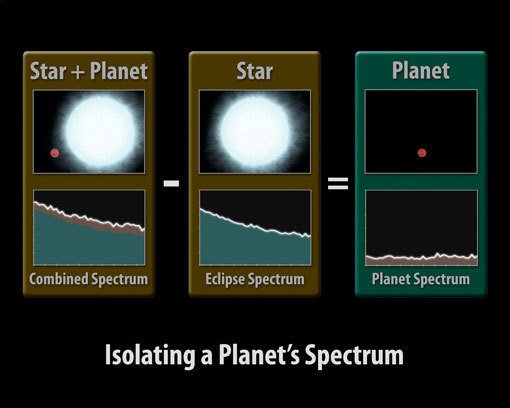
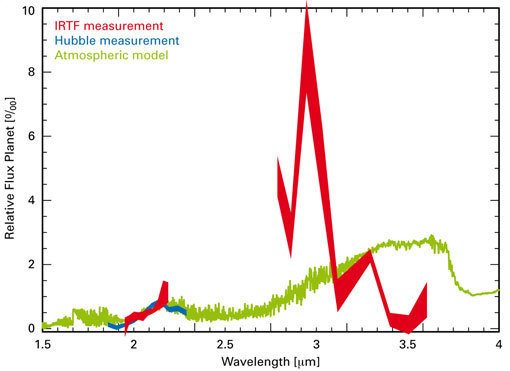
Download area
